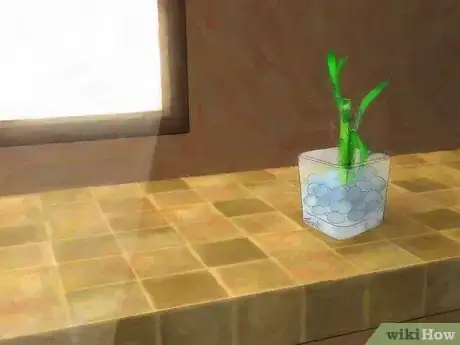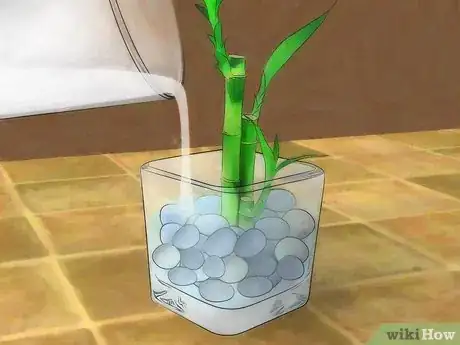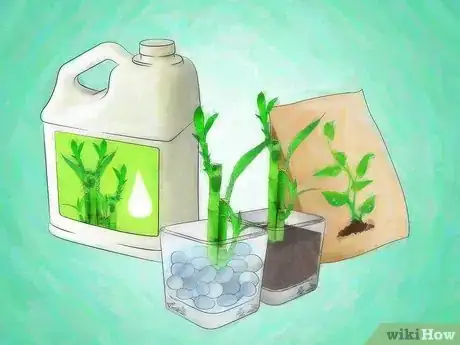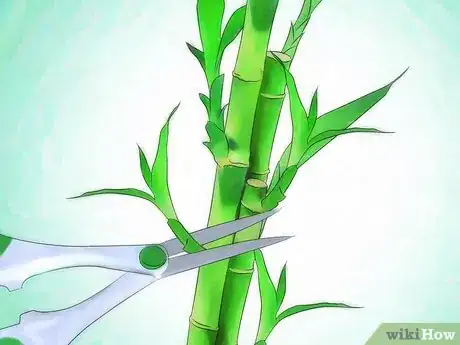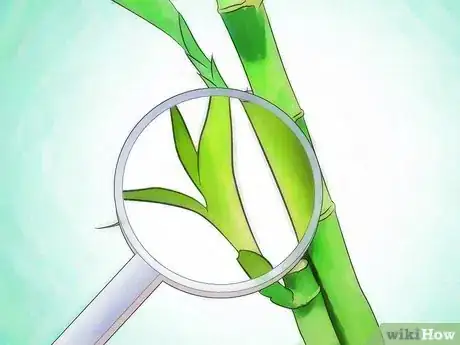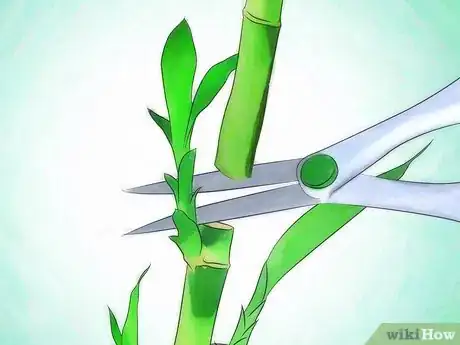This article was co-authored by Katie Gohmann. Katherine Gohmann is a Professional Gardener in Texas. She has been a home gardener and professional gardener since 2008.
wikiHow marks an article as reader-approved once it receives enough positive feedback. This article received 97 testimonials and 97% of readers who voted found it helpful, earning it our reader-approved status.
This article has been viewed 1,208,165 times.
Lucky bamboo is an easy-to-care-for houseplant that grows well in low, indirect light. This plant, which isn't really bamboo at all, but instead is a type of tropical water lily called Dracaena sanderiana, is from Africa and is said to bring good luck and good fortune to the inhabitants of any space where it is grown. With a few tips, your lucky bamboo will be healthy and thrive - and make you lucky to boot!
Steps
Setting Up and Choosing Your Plant
-
1Look for a plant with bright green leaves. If the leaves or stems are yellow or brown, this means that the plant is unhealthy. The plant has likely been shipped from China or Taiwan, so it's been through quite a trek.[1]
- Professional growers take the stalks and braid and curl them into intricate designs. Larger, more intricate designs result in some lucky bamboo plants costing hundreds and hundreds of dollars.
- A plant kept in a pot can grow up to 3 feet (0.9 m) high. If it's grown in soil outside, it may reach a height of up to 5 feet (1.5 m).[2]
-
2Decide if you want to grow it hydroponically or with soil. It's probably easiest and a little cleaner to grow in water and stones, though it can also grow in soil. Ultimately, it's up to you and will likely be determined by the pot or vase you have available.
- If you do go the stone route, the container should have enough stones or marbles in the bottom to stabilize it. The lucky bamboo will need at least 1 to 3 inches (3-8 cm) of water to thrive.
- If you want to grow it in soil, well-drained, rich potting soil is best. It needs to stay moist but not soaking at all times. Use organic fertilizer when needed; salts and high phosphorus concentrations in synthetic fertilizers can cause deterioration. Also, you can be sure your soil drains well by simply adding some small rocks to the bottom of the pot.
Advertisement -
3Use the right container. Put the lucky bamboo in a tall glass vase or ceramic container – no shallow bowls – or leave it in the container it comes in. A clear container is great if you just want to grow the plant hydroponically with some decorative stones; use a regular terra cotta pot if you want to grow it in soil.
- Keep in mind that the plant needs to be stabilized at its peak height. Your container should be at least 1 foot (30 cm) in height.
- Using soil? Fill the pot up most of the way with your rich soil and make sure it can drain well.
-
4Choose the right spot. Lucky bamboo do best in bright, filtered sunlight – think of the light that creeps through the top of a forest canopy. Direct sunlight will scorch the leaves. And as for temperature, keep it away from the air conditioning or vent. This plant prefers an air temperature between 65ºF and 90ºF.[3]
- If you want to control the curl of your plant, use a three-sided box (a box with a side cut out). The plant will then bend toward the light. As it curves, change the side the sunlight faces, and the plant will curve back.[4]
Helping Your Plant Grow
-
1Place the lucky bamboo in a warm spot where it will get indirect light. Keep an eye on how much light the plant gets – if anything, too little light is better than too much.[5] While you're gone, turn the air off, too. It'll be nicer for the plant if it's a little warmer.
- As the seasons change, you may want to move the plant. Take it away from any windows if you're unsure. It'll still get plenty of light in the center of a room.
-
2Change the water every week if you're growing it hydroponically. And as for what water to use, this plant is very sensitive to chemicals like fluoride and chlorine – only use tap water if it's been sitting out for 24 hours (so the chemicals can evaporate. Otherwise, bottled water is best.
- Once the plant has grown roots, the roots must be kept covered with water. Again, 1-3 inches is all it takes.
-
3Water the plant carefully. If you're growing your plant in soil, water it just enough so the soil is moist but not soggy. Keep it this way every day. The plant can get dry-rot if the soil is too wet. You can also spray the leaves with water to keep it moist and humid. Again, use filtered or bottled water to avoid chemical damage.
- Encourage more roots by increasing the amount of water in which the plant is growing. More roots mean lusher top foliage; the higher the water is up the stalk, the higher up the roots will grow.
-
4Fertilizer your plant every month or so. If you're using soil, use organic fertilizer every month or so so the plant gets enough nutrients (again, go organic as synthetic can cause deterioration). If you're growing it hydroponically, use liquid fertilizer in the water. However, keep in mind that lucky bamboo does not need much fertilizer, so make sure that you dilute the fertilizer to one tenth of its strength.[6]
- Add it at the same time as you add the rest of the water; it's best to add fertilizer when the water is clean.
Troubleshooting Lucky Bamboo
-
1Prevent tip burn by using filtered or bottled water. Tip burn is when the leaves start to become dry and dead. This often happens when there are chemicals in the water. Setting your tap water out may not be enough – you may need to switch to bottled water to get your plant to look healthy.
- Once it gets tip burn, it may be hard to get rid of. Even if you do switch water, some chemicals may reside in the plant. You may just have to wait it out as it should go away eventually.
-
2Trim the plant. Over time, most of these plants become top heavy. Because of this, trimming is very important for it to stay healthy. Don't cut off the main stalk – just the offshoots. Use sterile snippers to do so.
- Trim them off within an inch or two (2.5 - 5 cm) of the base. New shoots will emerge and the plant will be bushier and healthier.
-
3Pay attention to the color of the leaves. If they're dry and dying, that's a water problem as discussed above. If they're yellowing, that's often a result of too much sunlight or too much fertilizer.[7] If they're brown, try making the area more humid by spraying the plant with water.
- As for mushy leaves, this plant could be beyond saving. Remove them immediately, change the water, and replant what you have left.
-
4Cut the plant if you must. If part of the plant is dying, you may have to cut it off. For example, if you notice that the base of the plant is turning yellow, then this is root rot and the plant will die. You can cut the top of the plant off and replant it, but there is a chance it may not grow. You may also consider cutting the plant if you don't like the shape the plant is taking on. Whatever you do, don't throw away the trimmings – they can be made into a new plant. New shoots will emerge from the bottom, older piece of the plant, and the top section can be potted to grow on its own.
- If you have a dying plant, get rid of the decaying parts immediately. Take any alive stems or branches and immediately repot them. They may flourish on their own if you take swift action.[8]
Expert Q&A
Did you know you can get premium answers for this article?
Unlock premium answers by supporting wikiHow
-
QuestionCan I use decorative glass stones in the pot instead of rocks?
 Katie GohmannKatherine Gohmann is a Professional Gardener in Texas. She has been a home gardener and professional gardener since 2008.
Katie GohmannKatherine Gohmann is a Professional Gardener in Texas. She has been a home gardener and professional gardener since 2008.
Professional Gardener
-
QuestionIs the lucky bamboo plant poisonous to cats?
 Katie GohmannKatherine Gohmann is a Professional Gardener in Texas. She has been a home gardener and professional gardener since 2008.
Katie GohmannKatherine Gohmann is a Professional Gardener in Texas. She has been a home gardener and professional gardener since 2008.
Professional Gardener
-
QuestionI have a new plant that is rubber banded to hold the stalks together. Can I remove the bands?
 Katie GohmannKatherine Gohmann is a Professional Gardener in Texas. She has been a home gardener and professional gardener since 2008.
Katie GohmannKatherine Gohmann is a Professional Gardener in Texas. She has been a home gardener and professional gardener since 2008.
Professional Gardener
wikiHow Video: How to Grow Lucky Bamboo
Warnings
- Keep lucky bamboo out of the reach of young children and pets; the leaves are toxic if ingested.⧼thumbs_response⧽
- Do not expose your lucky bamboo to temperatures lower than 50 degrees F (10 degrees C). These tropical plants need warm, comfortable temperatures.⧼thumbs_response⧽
- Do not place your lucky bamboo somewhere where it will get too much sunlight. This will burn the plant, turning the leaves yellow, then brown.⧼thumbs_response⧽
Things You'll Need
- Tall container or pot
- Rocks or marbles
- Water
- Soil
- Fertilizer made for Lucky Bamboo (optional, and not usually necessary)
References
- ↑ http://houseplants.about.com/od/typesofhouseplants/a/LuckyBamboo.htm
- ↑ http://homeguides.sfgate.com/big-lucky-bamboo-get-68173.html
- ↑ http://houseplants.about.com/od/typesofhouseplants/a/LuckyBamboo.htm
- ↑ http://homeguides.sfgate.com/big-lucky-bamboo-get-68173.html
- ↑ http://houseplants.about.com/od/typesofhouseplants/a/LuckyBamboo.htm
- ↑ http://www.flowershopnetwork.com/blog/flower-plant-care/plant-care/caring-for-lucky-bamboo-dracaena-sanderiana/
- ↑ http://houseplants.about.com/od/typesofhouseplants/a/LuckyBamboo.htm
- ↑ http://houseplants.about.com/od/typesofhouseplants/a/LuckyBamboo.htm
About This Article
To grow lucky bamboo, start with a healthy-looking plant with bright green leaves and stems. Select a glass or ceramic container with tall sides to grow it in, since this will give your plant extra stability as it gets taller. If you want to grow your bamboo hydroponically, or without soil, place enough stones or marbles at the bottom of the container to stabilize the plant. Otherwise, plant your bamboo in organic, well-drained potting soil. Set the container in a warm spot that stays between 65° and 90° F (18-32° C) and gets lots of bright, indirect sunlight, such as next to a sunny window. If you’re growing the plant hydroponically, change the water once a week. Make sure there’s always 1-3 inches (2.5-7.6 cm) of water in the bottom of the container. Lucky bamboo can be sensitive to chemicals such as chlorine, so use bottled or filtered water instead of tap water when you can. If your bamboo is planted in soil, keep the soil damp but not soaking wet. Once a month, add a bit of fertilizer diluted to 1/10th strength to the water or soil. Look for a fertilizer formulated for lucky bamboo online or at your garden center and follow the instructions on the package to add it to the soil or water. If your bamboo starts to get top-heavy, or if you notice dead or decaying leaves or stems, snip off the unwanted or damaged shoots with sterile clippers.




